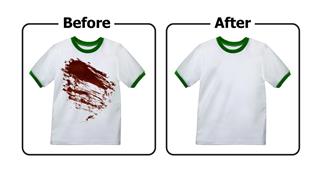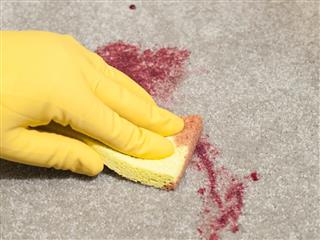
Most householders have often wondered how to remove blood stains from fabric, wood, or leather. It is certainly not an easy task to remove it from most surfaces (other than glass) once they have set in. However, it is possible to do so with some basic knowledge.
All of us have to deal with blood stains some time or the other. It is best to get them removed when they are fresh and not to let them set in. These stains are not as easy to remove as mud or grime, which can be removed just with plain water even though they may have already set in. Blood contains proteins that bind themselves tightly to fibers in fabrics, which makes them difficult to be removed. However, it is not impossible to remove them. The following passages elucidate different methods of removing blood stains from different materials listed below.
From Non-washable materials
To get rid of blood stains from acetate, burlap, fiberglass, rayon, silk or wool, one must treat the stain as soon as possible. It is important that one does not give the blood stain time to set. Use a dampened cloth to sponge the stain with cold water, using light strokes and working outward from the stain’s center. This works well if the blood is still wet. In case of any remnant stains, one can apply a wet pad with a few drops of ammonia. However, one should not use ammonia on silk and wool. After this, one should cover the sponged area with an absorbent pad dampened with the ammonia-suffused pad. This poultice needs time to work on the blood stain, and one should change it as often as it is required. After this, one can flush the area thoroughly with cool water, ensuring the removal of all ammonia.
From Washable Materials
One can generally do away with blood stains fabrics laundering them in cold water. One can soak any remnant stain with a solution consisting of a quart of warm water, half a teaspoon of dishwashing or liquid laundry detergent, and a tablespoon of ammonia for fifteen minutes. One should scrape off any excess solid or caked-on stains and blot occasionally with an absorbent pad. Repeat this process till the stain is completely removed. Afterwards, rinse the area well with water, once again ensuring that no ammonia remains. One can then dry or launder the fabric.
From Hard Surfaces
To wash off stains from aluminum, asphalt, brass, bronze, ivory, or linoleum one can wipe up the blood stain with a sponge or cloth soaked in cool or warm, soapy water. Then one can dry the area with a clean cloth. To treat the stains on alabaster or marble, one should wipe the blood stain with a sponge dipped in cold water and apply a poultice of water, powdered detergent and chlorine bleach on any remaining stain. One must apply this poultice thickly and cover it with a damp cloth to discourage premature drying.
From Carpets
To get rid of stains from synthetic or woolen carpets, one needs to spray a product, such as Stain-X Carpet Stain Remover on the affected area. One can also mix a teaspoon of mild, non-alkali detergent with half a pint of lukewarm water, apply some of this to the stain, and blot the liquid. It is important not to rub the stain further into the fibers. The blotting process continues until the stain vanishes. If any stains persist, one can add a tablespoon of ammonia to a cup of water and sponge the stain with this mixture, blotting it afterwards. Placing an absorbent pad over the damp area and weighing it down will draw out all excess liquid.
From Natural or Synthetic Fur
To remove blood stains from natural or synthetic fur, blot up the blood, soak a cloth in mildly soapy water laced with a few drops of ammonia and rub this solution into the stain carefully. Then rinse by dipping a cloth in cool water, wringing it partially dry and stroking the area with this carefully. The area should dry naturally, with no artificial heat.


